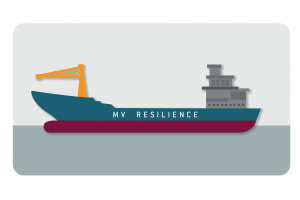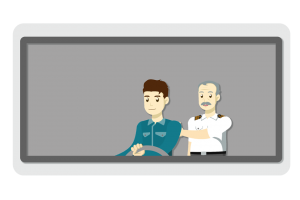Resilience is a buzzword that many organisations are using to describe what they do, how they work, and who they are. Building resilience must permeate the entire organisation. Sometimes it is not clearly explained what makes an organisation or a unit like a vessel resilient. We have previously described how resilience is built through increased employee engagement. In this article we look at it from a Chief Officer’s perspective. From he embarks till he signs off, with focus on one complete voyage from port to port.
What is resilience?
But first, let us try to define again what exactly is resilience?

Different organisations have varying perspectives and ways of defining resilience.
Here are some examples:
The American Psychological Association gives this definition of resilience: the ability to adapt well to adversity, trauma, tragedy, threats, and even significant sources of stress.
In their Rick Rescorla National Award for Resilience, the United States Department of Homeland Security uses Resilience as one of the criteria and defines it as the ability to effectively prepare, respond, and recover in the face of disasters.
Shell, in their Resilience and reflective learning programme, defines resilience as the ability to bounce back after a stressful situation.
In our Safety DeltaTM, we define resilience as the ability to overcome challenges across varying conditions and to learn from positive as well as negative experiences. A high level of employee engagement is key and and a prerequisite for people to be able to contribute to change. Engagement is strongly stimulated through Safety Delta.
Indeed, resilience is defined in many ways.
But for a seafarer like me working in an industry where resilience is a mantra and part of the standards, it is important that I know what resilience looks and feels like.
Fortunately, during my years of working at sea, I have been given the opportunity to go on a voyage as a Chief Officer with the MV Resilience where I met and worked with a resilient Captain and crew. Join me as I look back on that one complete voyage, which was from a loading port to a discharging port. I will highlight events in my voyage in which the resilient qualities of the Captain and crew are exemplified.
Boarding the MV Resilience

My impressions of the level of safety culture on board MV Resilience started to shape up upon stepping on the gangway for the first time. The gangway looked clean, it was landed on the quay, and its net was fastened. There, an AB on watch and a Duty Officer, who were both wearing complete PPE, met me. They ran me through the security protocol. Then they were asked by the Captain via the radio to accompany me to his office.
In his office, the Captain checked my papers and briefed me regarding my emergency stations. After all the necessary paperwork and briefing were done, he told me to take a rest since I came from a long flight. He also reminded me that that the vessel would sail in approximately 48 hours.
Ship’s familiarisation/Induction
I had taken enough rest when a Duty Officer knocked and came inside my cabin. He told me that we would have the ship’s familiarisation. He handed me the ship’s familiarisation form. He explained each item in the document and encouraged me to ask questions. He also toured me around the vessel. After the ship’s familiarisation, he gave me the handover notes since I would be the one to relieve him. We discussed the handover notes before he left me.
Resilience waypoint 1
I have joined many vessels where I had negative experiences. For example, on occasions I had to jump over a gap between the gangway platform and the quay since the vessel’s Captain and crew were not informed that I would arrive; even without rest and proper handover, I had to proceed with my duties right after joining the vessel; and I did not have the ship’s familiarisation until days after I had joined the vessel.

Boarding the MV Resilience gave me a new, positive experience. It’s Captain and crew showed resilience by demonstrating effective coordination and communication in assisting a newly-embarked crew member like me; having and following the established procedures in preparing and familiarising me to my duties and to the ship; providing me with necessary knowledge and information; and showing care and concern about my health and well-being.
Loading operations
The next day, I had a meeting with the Captain, the Chief Engineer, and the Second Engineer. The Captain initiated the meeting by asking about the status of the loading operation and if there were challenges. Then he mentioned that food provision and stores would arrive at 1200H and bunker barge at 1300H. Everyone was given time to share ideas and raise concerns.
The Chief Engineer shared his decision of postponing some minor preventive maintenance to accommodate the bunkering operation and expressed his concerns of not having enough hands to assist in receiving the bunker barge. As Chief Officer, I also expressed my concern of being short of hands in attending the provision and stores lifting. The Captain responded, “So what is your suggestion?” The Chief Engineer suggested that the engine crew should take half day off until the bunker barge or the food provision and stores arrived to avoid extending their work hours. “Thanks for your idea – it sounds good. Let’s do it.” the Captain replied to the Chief Engineer.
Resilience waypoint 2
I have been on vessels where only the Captain decides what to do – and where he did not even bother to listen to the crew’s suggestions. My experience on board the MV Resilience supports my belief that a resilient leader is the one who listens to his crew and encourages them to speak up.
MV Resilience’s Captain kept his crew informed and gave them opportunities to speak up. He listened more and talked less. He acknowledged and appreciated his crew’s ideas. He made everyone feel they were part of the solution, thereby driving his crew’s strong commitment and high performance. In other words, everyone has a high level of engagement.
Pilot on board – ship’s departure for sea
The Pilot boarded and was accompanied to the bridge. He was met by the Captain and right away the Pilot-Captain information exchange was initiated. The Captain insisted that the Duty Officer be included in the discussion. ”Point of no return” and other concerns were discussed. The Captain then met with the bridge team and explained the pilot plan. I was stationed to the forward and thereby had a toolbox talk with the Bosun and the forward station team. The deck crew showed assertiveness by asking a lot of questions and clarifying what they did not understand. The Bosun was very particular about the “Point of no return” – what exactly he needed to prepare and do in worst case scenarios.
I told the team that as soon as all lines were secured, we would prepare both anchors, ready to be released. The OS and AB asked if they needed to stay until the Pilot disembarked. So, I had to clarify that all should stand by until we cleared the Pilot.
As the vessel was navigating along a narrow channel, I was called to the bridge. I noticed that the Pilot was busy guiding the ship. Every time he made his helm orders, he accompanied it with a hand gesture. When he ordered the hard starboard, he used his right and left hand to order the port rudder.
While approaching the pilot drop-off point, the Pilot was talking to the pilot boat via the radio and giving a helm order hard port by signalling his right hand (starboard). The Helmsman was confused with the order and then asked the Pilot, “Sir, is it port or starboard?” The Duty Officer clarified the order from the Pilot. The Pilot realised his mistake and corrected himself. The Captain told the Pilot, “I’ll take the command and bring the vessel to the pilot drop-off point, so you may prepare for your disembarkation”.
Resilience waypoint 3
A collision with the inbound vessel, which was picking up another pilot would not have been prevented if the helmsman or the Duty Officer did not monitor and clarify the Pilot’s helm order. The bridge team’s resilience, which was reflected in their alertness and assertiveness, just prevented the collision.
The bridge team was well informed of the situation and definitely showed high level of situational awareness and assertiveness. They did not hesitate to challenge because everyone knew the plan and expectations clearly. Everyone, especially the ratings, freely asked questions and spoke up to clarify matters. Indeed, from top to bottom, there was an open communication.

At sea safety meeting
The next day, a Saturday at sea, the Captain conducted a safety meeting. He opened the meeting by recognising and thanking everyone for yesterday’s safe operation. Then he ran through the minutes of the previous meeting and discussed the lessons learned from yesterdays’ nearmiss – the averted collision. He encouraged everyone to share ideas and discuss different or opposing points of views regarding the nearmiss incident.
On deck
After my watch, I went out for a walk on the deck. I was in a hurry to take my first walk on deck while at sea. I was walking along the bunker station when an OS approached me and said, “Chief, you don’t have a helmet.” I then replied, “Oh, I forgot my helmet. Thanks for reminding me”.
Resilience waypoint 4

My next days at sea affirmed that the Officers and crew on board the MV Resilience are indeed resilient. They showed resilience by being able to intervene or stop any unsafe acts or behaviours, regardless of rank. They gave either corrective or appreciative feedback right after an act or a behaviour was observed.
Arrival at port of discharge
After three weeks of sailing, the vessel was now a day from reaching the next port. A pre-arrival meeting was carried out and everyone had the chance to speak up. The Captain facilitated the meeting smoothly and set his safety and operational expectations for everyone.
When my time to bid goodbye to the MV Resilience came I disembarked and brought with me the lessons learned. My experience on board the MV Resilience taught me that a resilient safety culture indeed is woven by the hands of resilient leaders and crew.
Leaders who set clear expectations:

And crew who have high level of engagement:

Both have the ability and willingness to prepare for, respond to, and bounce back from any situations along the way because they know that beyond the calm seas, storms of challenges await.
Contact us for personal advice
Would you like us to call you?

